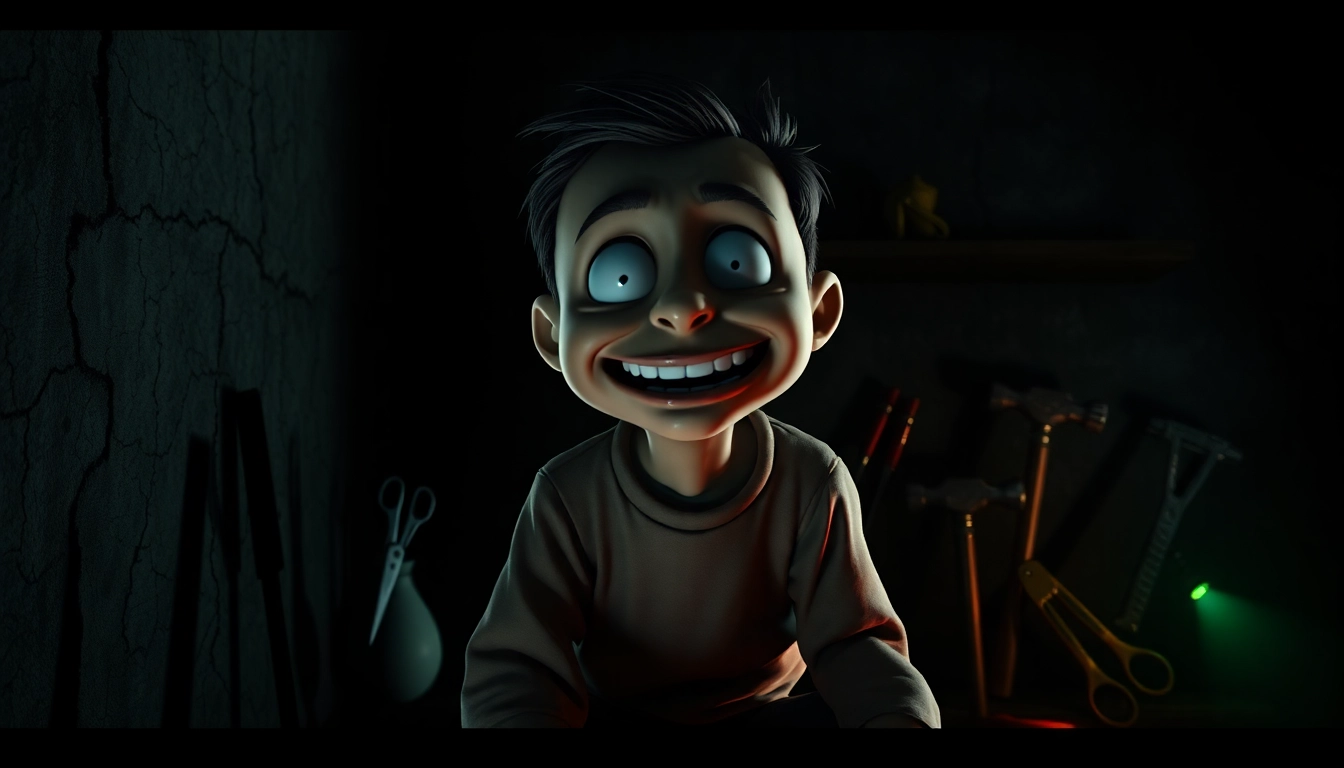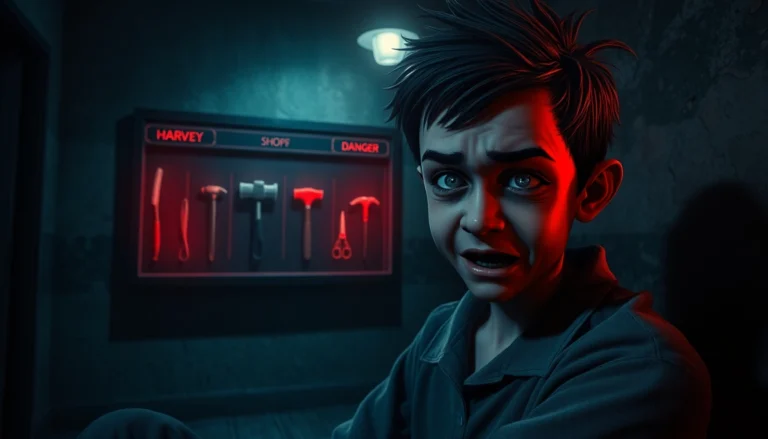
Overview and Context: BloodMoney – A Dark Psychological Clicker Experience
In the realm of psychological horror gaming, few titles evoke the visceral discomfort and moral introspection as harvey blood money. This dark clicker game plunges players into an unsettling world where each interaction not only yields profit but also chips away at the moral boundaries of the player and the character they control. The game’s premise is simple yet profoundly disturbing: you are diagnosed with a life-threatening condition, and your urgent need for $25,000 sets the stage for a moral dilemma that challenges your conscience. To meet your medical bills, you are introduced to Harvey—a cheerful, seemingly innocent character whose suffering increases with each click you make. As you click on Harvey, he endures pain, and your wealth grows, but the visuals grow darker and more disturbing, testing your psychological resilience and moral compass.
This article explores the intricate mechanics, narrative depth, and community insights surrounding blood money, a game that masterfully combines clicker gameplay with visceral horror elements. It asks: How far are you willing to go when every dollar earned costs someone else their dignity, their pain, or even their life? The answer varies, and the game’s multiple endings reflect the spectrum of human morality—from minimal harm to outright brutality.
The Dark Narrative of BloodMoney and Its Community Insights
At its core, blood money crafts a haunting narrative about desperation, morality, and human nature. The player embodies someone desperate for survival, caught between the harsh realities of medical bills and the disturbing mechanism of earning money through the suffering of Harvey. The community around BloodMoney is deeply engaged with its psychological layers. Players share their experiences, theories, and moral reflections, often debating whether the game is an indictment of capitalism, a mirror of human depravity, or a test of individual morality.
Many gamers note Harvey’s cheerful demeanor as a stark contrast to the increasing violence of the tools available—scissors, needles, hammers—each escalating the level of pain inflicted upon him. The subtle visual cues and Harvey’s evolving reactions serve as a mirror to players’ conscience, prompting reflection on how moral boundaries shift under pressure. Community discussions often highlight the game’s ability to evoke genuine emotional responses, with players admitting feelings of guilt, helplessness, or even justification as they progress. These insights reveal that BloodMoney isn’t just a game; it’s a psychological experiment on human empathy and moral resilience.
Game Mechanics: Clicking, Upgrades, and Moral Consequences
Clicking Mechanics and Earning Money
The fundamental mechanic of BloodMoney revolves around clicking on Harvey—each click generating a fixed sum of money. Initially, the process seems innocuous; Harvey’s cheerful smile and bright dialogue masks the underlying horror. As players click, their total increases, but so does Harvey’s pain, which is visually represented through subtle changes in his expressions and body language. This creates an immediate tension: the more you click, the more you profit, but at what cost?
Upgrade System and Increasing Unsettling Tools
To accelerate earnings, players can purchase upgrades from the in-game shop. These upgrades include tools designed to maximize profit—needles, hammers, and other violent implements—each with escalating levels of brutality. The choice of tools directly impacts Harvey’s suffering and the visual tone of the game. For example, using scissors might result in a moderate increase in profit, while employing a hammer could significantly boost earnings at a grievous cost.
The upgrade system introduces a layered moral dilemma: do you prioritize quick financial gain or minimize Harvey’s suffering? The game subtly tracks your choices, influencing the eventual ending. Each upgrade not only affects Harvey’s pain but also alters his visual appearance and reactions, reinforcing the emotional toll of your decisions. This dynamic creates a twisted risk-reward loop—more violent tools yield higher profits but deeply disturb the player’s moral sensibility.
Moral Choices and Their Impact
Every decision, from the tools you purchase to the amount of harm inflicted, shapes Harvey’s fate and the story’s conclusion. The game doesn’t overtly penalize violent choices but instead offers different endings based on your actions. Choosing to inflict minimal harm might lead to a more compassionate ending, while maximizing efficiency regardless of suffering results in a darker, more nihilistic conclusion. This design encourages players to reflect on their own morals and the societal implications of greed and desperation.
Visual and Emotional Design: Building an Unsettling Atmosphere
BloodMoney excels in creating a visceral atmosphere that intensifies as the game progresses. The visuals are minimalistic yet deeply effective—Harvey’s facial expressions become more strained, his body language more tense, and the background dimmer. The lighting subtly shifts to evoke a sense of dread, and the dialogue becomes increasingly desperate and fearful. The game’s sound design complements these visuals, with unsettling ambient noise and muffled screams that heighten the psychological tension.
The emotional impact of the game hinges on its ability to evoke empathy for Harvey while simultaneously confronting players with their own moral boundaries. For example, Harvey’s reactions—surprise, pain, fear—are portrayed with subtlety but carry profound emotional weight. The game’s use of visual cues, dialogue, and sound creates an immersive experience that makes the moral dilemma feel personal and urgent.
The Moral Complexity of Harvey and Player Decisions
Harvey is more than just a silent victim; he is a symbol of innocence, hope, and vulnerability. His cheerful demeanor at the start contrasts sharply with his suffering as the game advances, creating a powerful emotional dichotomy. Players often report feeling conflicted—guilt and sympathy clash with the desire to reach their goal.
Interestingly, some players have observed that Harvey appears genuinely surprised by the more violent tools, such as the hammer. This subtle detail suggests Harvey may not fully comprehend the extent of the harm inflicted or perhaps expects harmless items like pillows. This raises profound questions: Is Harvey aware of his suffering? Is he complicit or unaware? Does this innocence justify certain choices, or does it serve as a moral mirror?
The game’s design invites players to examine their own moral compass: are we inherently good or evil when pressed by desperation? The duality embodied by Harvey—the innocent victim—and the dark, profit-driven shop creates a layered narrative about human nature that resonates long after the game ends.
Multiple Pathways and Endings: The Spectrum of Human Morality
The Good Ending
Achieving the Good Ending requires the player to minimize Harvey’s suffering while still reaching the financial goal. This might involve choosing less violent tools or limiting clicks. In this ending, Harvey’s appearance remains relatively intact, and his reactions are compassionate and hopeful. The moral takeaway emphasizes that even in desperate circumstances, compassion can prevail.
The Normal Ending
The Normal Ending is attainable through moderate choices—using scissors or occasionally inflicting more pain but not to the extreme. Harvey’s suffering is evident but not overwhelming, and the ending reflects a compromise between morality and necessity. This path highlights the ambiguous space where survival instincts clash with moral values.
The Bad Ending
The Bad Ending is the consequence of maximizing profit regardless of Harvey’s pain—using the hammer or other violent upgrades freely. Harvey’s appearance is grotesque, and his reactions are filled with terror and despair. The game’s conclusion in this scenario is bleak, emphasizing the destructive potential of greed and moral abandonment.
These endings serve as a reflection of real-world moral choices, prompting players to consider their own limits and the societal implications of prioritizing profit over human dignity.
Community Insights and Player Reactions
The BloodMoney community is vibrant and deeply engaged with the game’s moral and psychological layers. Players share their playthrough strategies, moral reflections, and emotional reactions on forums and social media. Many express that the game made them question their own values, with some admitting feelings of guilt or discomfort after inflicting harm—even in a virtual setting.
YouTuber and gamer SHROOMYCHRIST, among others, have highlighted the emotional intensity of the experience, noting how the game’s subtle cues and Harvey’s reactions evoke genuine empathy. Other players have pointed out the game’s clever design—how it tracks choices more subtly than initially apparent, influencing endings based on nuanced decision-making.
The community also discusses the symbolism behind Harvey’s innocence and the dark shop, interpreting the game as a commentary on capitalism, exploitation, and human morality. Many see it as a mirror held up to society—questioning whether survival instincts justify morally questionable actions.
The Broader Implications: Morality, Survival, and Human Psychology
BloodMoney is more than just a horror game; it’s a psychological mirror that explores fundamental questions about human nature. It challenges players to confront their own morality in the face of desperation. The game’s design reveals that morality isn’t fixed but can shift depending on circumstances, highlighting the fragility of ethical boundaries.
Psychologically, the game taps into primal fears—poverty, illness, and death—exacerbated by the visual and auditory cues that create a sense of dread and helplessness. It raises uncomfortable questions: how much are we willing to sacrifice? When does survival override morality? And what does that say about us as individuals and as a society?
Research in psychology suggests that situations of extreme stress often lead to moral disengagement, a phenomenon vividly illustrated in BloodMoney. The game’s success lies in its ability to evoke genuine emotional responses, prompting reflection on the darker facets of human nature.
Conclusion: The Power of Psychological Horror in Gaming
BloodMoney exemplifies the power of psychological horror to probe the depths of human morality. By intertwining addictive clicker mechanics with visceral visual storytelling, it offers a disturbing yet compelling exploration of what individuals are willing to do for survival. The game’s multiple endings serve as moral signposts, guiding players to reflect on their choices and their implications.
Ultimately, BloodMoney is a mirror held up to society—a stark reminder that beneath the veneer of civility lies an unsettling capacity for greed, cruelty, and moral compromise. Its success in evoking emotional responses and moral reflection cements its place as a significant, if unsettling, piece of interactive storytelling.
As you navigate the dark corridors of this psychological journey, remember that each click, each decision, shapes Harvey’s fate and your own moral landscape. Are you willing to push the boundaries of your conscience? Or will compassion guide your actions? The choice is yours in blood money.




